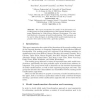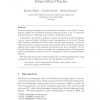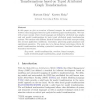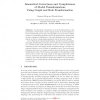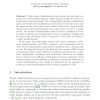124
click to vote
ENTCS
2006
15 years 18 days ago
2006
A taxonomy of model transformations was introduced in [18]. Among others, such a taxonomy can help developers in deciding which language, forma lism, tool or mechanism is best sui...
98
Voted
ENTCS
2006
15 years 18 days ago
2006
This report summarises the results of the discussions of a working group on model transformation of the Dagstuhl Seminar on Language Engineering for Model-Driven Software Developme...
110
click to vote
ENTCS
2006
15 years 18 days ago
2006
Model transformation means converting an input model available at the beginning of the transformation process to an output model. A widely used approach to model transformation us...
101
click to vote
ENTCS
2006
15 years 18 days ago
2006
Using graph transformation as a formalism to specify model transformation, termination and confluence of the graph transformation system are often required properties. Only under ...
119
click to vote
ENTCS
2006
15 years 18 days ago
2006
In this paper we present a model transformation from a visual representation (VisualOCL) of the Object Constraint Language (OCL) to the textual one using graph transformation. Sta...
ENTCS
2006
15 years 18 days ago
2006
With the growing importance of model-driven development, the ability of transforming models into well-defined semantic domains becomes a key to automated code generation or verifi...
114
Voted
ENTCS
2006
2006
Overview of Formal Concepts for Model Transformations Based on Typed Attributed Graph Transformation
15 years 18 days ago
In this paper we give an overview of formal concepts for model transformations between visual languages based on typed attributed graph transformation. We start with a basic conce...
93
Voted
GG
2008
Springer
2008
Springer
Semantical Correctness and Completeness of Model Transformations Using Graph and Rule Transformation
15 years 1 months ago
An important requirement of model transformations is the preservation of the behavior of the original model. A model transformation is semantically correct if for each simulation r...
91
Voted
GG
2008
Springer
15 years 1 months ago
2008
Springer
Abstract. Triple graph transformation has become an important approach for model transformations. Triple graphs consist of a source, a target and a connection graph. The correspond...
94
Voted
SPLC
2008
15 years 2 months ago
2008
Model-driven software product lines are an emerging topic in research and industry, as they promise higher development speed and easier adaptability to customer needs. The generat...

